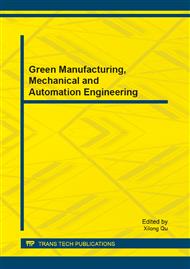p.69
p.75
p.80
p.85
p.90
p.95
p.100
p.104
p.111
Stream Turbine Vibration Fault Diagnosis
Abstract:
RBF neural networks possessed the excellent characteristics such as insensitive on the initial weights and parameters with artificial fish-swarm algorithm (AFSA) applied, which made it have abilities to get rid of the local extremum and obtain the global extremum, and called as AFSA-RBF neural networks. In this paper, a new stream turbine vibration fault diagnosis method was presented based on AFSA-RBF neural networks. After quantification and reduction of the diagnosis decision table, the simplified decision table served as the learning samples of AFSA-RBF neural network, and the well-trained neural network was then applied to diagnose stream turbine vibration faults. The diagnosis results show that the proposed method possesses higher convergence speed and diagnosis precision, and is a very effective turbine fault diagnosis method.
Info:
Periodical:
Pages:
90-94
Citation:
Online since:
July 2013
Authors:
Price:
Сopyright:
© 2013 Trans Tech Publications Ltd. All Rights Reserved
Share:
Citation:


